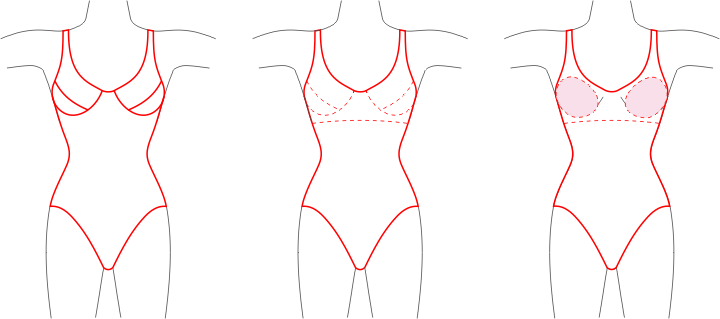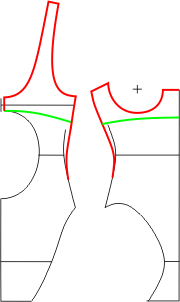Swimwear Bras
Only If You Really Feel You Must ...
I am filled with a great deal of anxiety when covering this topic as it is likely to spur a flurry of email. I will start by saying, if you don't need bust support in swimwear then you really shouldn't use it ... at all. The complexity and cost of construction is often unwarranted and limits profit margins significantly ... eg; you may only be able to charge 10-15% more for a swimsuit with a built in bra, but it might cost you 30-50% more to make. If I had a dollar for every person that said "but it's just a piece of wire, why does it cost an extra $20?" I'd be living a much more comfortable life! When confronted with a price difference, most women who don't really need them, automatically justify not needing a built in bra. One needs to consider what the swimwear is being used for and for how long. People with a very large bust clearly need both support and separation (the uniboob created by a shelf bra is often not a good look) so you have no argument from me there. People with a moderate bust size may benefit from support if they use the garment for extended periods of time. But without doubt, the reason most people want a bra built into a swimsuit is for shape and/or enhancement ... the garment has become more about looks than about function and it is this that we need to consider in relation to construction cost when designing a ready to wear range.
The other things to consider are manufacturing standards and regulations in the country of sale of the end product. A while back, metal underwires were removed as acceptable from assorted manufacturing standards that had implications for swimwear. The concern is a safety issue of wires injuring the wearer. Swimwear is not often made to the safety level of lingerie bras, and should for some reason (like chlorine, salt, sun, lotions and chemicals) the wire come free and injure the wearer then the manufacturer is liable. Initially when this was realized by manufacturers there was a flurry of new warning labels, but thanks to legal action against one USA company it was established that the wearer was under no obligation to read the labels or even, for that matter, care for the garment according to the labelled instructions. Very quickly wires disappeared from 95% of swimsuits (at least the ones I was asked to do), which although you could still find them, tended to be built only into garments that really needed them. This was back in the late 1990's, since then wires have been creeping back slowly at the risk of the manufacturers (risk/cost analysis!). There was talk of a polycarbonate underwire to replace the metal wires, but I've not seen these personally. I understand that they do not have the stiffness of metal wires and do not function well under the tension of swimwear. I am not able to verify this.

The complete opposite end of this argument is for people with very little bust. Push up and other types of enhancement cups have become very popular. Either simply built into the bikini top or inserted and sewn directly into the liner of a one piece. The advantage of these padded foam cups is that they hold their own shape for small breasts and so no wire is generally needed. In fact I once took a premade foam booster cup and simply covered it with fabric to make the bikini top ... no wire, no construction, just strings, foam and fabric (photo to the right). Make sure the foam is a closed cell, non-urethane foam ... urethane breaks down in salt and chlorine, and open cell foam acts like a sponge and soaks up water ... closed cell does not soak up water but it does try to float a little. The fibre filled pillow type pads used in lingerie bras are completely useless in swimwear as they flatten out, fill with and hold water (it's to do with capillary action). If your swimwear comes with pad pockets, use high density silicone inserts or closed cell foam inserts.
I should also admit to a certain amount of bias. I don't, and have never, liked underwires in swimwear. Certainly they can add shape and support (and yes some people need this), but philosophically swimwear is a casual garment designed principally for fun and relaxation in the water. Water is buoyant and provides support in itself. It's much like the corset argument ... certainly these provide shaping and support but who wears them relaxing at home on the weekend? If you need the support and shaping then OK, but if not then choose a non-wired swimsuit.

Ok that's enough introduction and you're still reading because you want a bra built into your swimsuit. Whether it’s a one or two piece the rules are pretty much the same. The pattern making principles for each of the above have already been covered in;
• The Bra Cup Block
• The Bra Band Block
• The Tanksuit
• The Empire Line Maillot
So let's discuss each type. The image on the left is a one piece in which the bra elements are visible ...essentially a bra with an attached swimsuit. The central image is a one piece tanksuit in which a bra is not visible ... usually made from support netting and constructed as part of the liner. The right hand image is a tanksuit in which pre-shaped pads have been inserted into the liner as part of a shelf bra.
Going back to the first image, this swimsuit requires underwires and a very low stretch liner to make the cups such as Powernet or similar. The pattern is made according to the rules for the bra band and cup block, but allowing for the reduced negative ease of the support netting. Some bright people will perk up and ask if this means the liner and outer fabrics are different sizes ... no. The outer fabric negative ease is reduced to match that of the liner (eg; you might use 4% instead of the 12% in the swimsuit). Ease is still needed because a one piece does not have a centre back clip like a lingerie bra. Should the design allow for a clip then it's probably recommended to tighten the back straps a little more ... how much depends on the width of those straps. I would also use a non-stretch patch of nylon or polyester between the wires at centre front to stop the wires from separating. This is usually narrow enough to simply be cut from the block pattern, but technically it should be slightly larger as it will have no ease. Personally I prefer it to be the same size as the stretch components as it's easier to stitch and sits flatter on the sales rack. If there is a great deal of distance between your wires (>4cm) then you may be best to remove the ease to prevent too much loss of tension at centre front, which will result in ripple lines (not a good look at centre front bust).
The real question comes when you choose which way to make the body section. If you use the same support netting then the pattern pieces match as they have the same negative ease, so it's simply a matter transferring top pattern lines to the bodice. Keep in mind the underwire is drawn onto the block after the ease has been built in (technically wrong but isn’t done any other way besides making a zero ease garment - does happen too) so it assumes the garment is stretched slightly to insert the wire. I do this last so all the pattern pieces match during construction. You must also keep in mind how the garment will be put on because all this stiffer lining isn't going to like squeezing hips through the neckline. See the image below ... here's how design is important. The cut out means getting in and out is easier and that a clip can now be used to tighten (or even adjust) the bra component.

If you want to use standard liner in the bottom half you need to blend the side seams from the reduced ease of the bra section back down to normal negative ease of your one piece block/tanksuit pattern and decide where the change from support net to lining will occur. Most designers line all the way to the neckline and armholes, and use an additional layer of support netting for the bra band inside the garment. This means the fabric and liner are still at the reduced ease of the support netting at the top, but are then eased gently into the waist of the tanksuit.

Take a look at the image above ... the green line represents the limit of the support netting, the red is where the lining has had the ease reduced to match the support netting of the bra. Note that the band at the centre back has been shortened because of the lower back cut out.
The second style is where the bra is not visible. This is done exactly the same way as the first style except that the top fabric is cut as a tanksuit pattern while the support net and lining are done as above. The top fabric pattern simply needs to match the differing ease from bra to bodice as before by blending in at the side seam (ie; simply reduce the ease in the bust area of tanksuit pattern to match the ease used in the support netting (hint: close the dart before you do this!).
Last but not least, the third style is not really a bra because it tends to float around a bit. The objective is more to enhance shape by way of the preformed cup while the shelf provides minimal support. I'm not completely convinced that this actually works, but it does look better than no shelf and cups, and seems to be the most popular construction method for larger sizes ... although I think this has more to do with the wider range of people fitting the same size garment than anything to do with bust support! This pattern has already been fully descibed on the empire line maillot page. The liner is made as an empire line maillot and the top fabric as a tanksuit. Alternatively you could make a floating shelf from a reduced negative ease support netting and make the lining and top fabric as a tanksuit that has reduced ease in the bust section as per style two. The cups are simply pushed into the shelf and stitched in place ... you can even buy these shelves premade at some retail sewing stores. I like to fix a piece of non-stretch ribbon with an adjusting clasp (like in bra straps) between the cups to help improve fit and keep them in place ... some store bought cups have the joining strap but not the adjustor ... makes all the difference.